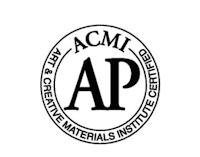
"Peonies in Crystal" -36 x 36"
This is my newest painting
and it has nothing whatsoever to do with the topic
of water soluble oils
It doesn't.

"A product can be certified non- toxic only if it contains no materials in sufficient quantities to be toxic or injurious to humans, or to cause acute or chronic health problems".
The focus of that designation is us.AP non toxic doesn't consider the plants, animals, and microorganisms that will be exposed to our pigment if we put it down the sink or in landfill where it will eventually break down and enter the watershed
.
Checking out the online MSDS sheets posted by every paint manufacturer will tell you a different story. Under environmental or aquatic toxicity, you'll find phrases like: "no data available" or "unclear".
Water mixable oils are, in fact, exactly the same as regular oils: they're made of the same dangerous pigments suspended in harmless vegetable oils, but they have an added emulsifier that allows you to clean your brushes with soap and water. This nifty development means that painters are washing hazardous waste down the drain.
Like the painters who use traditional oil paints, WM oil painters should be capturing the sludge from their brush cleaning and disposing of it at hazardous waste facilities.
Don't stop reading in despair and don't stop painting. This is not added work and complexity; it's actually easy!
To save your paint sludge, you just have to clean your brushes in a bucket of water instead of under running water in the sink. Put a grid (like these) at the bottom of the bucket so that pigment falls through and, when you have a layer of pigment collected under the grid, let the water sit for a day until the sludge settles to the bottom. Decant the clear water off the top for reuse, and scrape the pigment sludge into a separate, lidded container.
When this pigment container is full, label it as "Paint sludge, contains heavy metals/ cadmium" and bring it to your community's chemical collection site. In my city, landfills and some fire halls accept chemicals.
Easy peasy!
**I detailed the same process for traditional oil painters to reclaim pigment from solvent a few years ago in this blog entry.
FYI: acrylic painters must do the same thing. They use exactly the same toxic roster of pigments that oil painters use, and their paint water shouldn't go down the drain.
Golden Acrylics has information about capturing pigment from brush cleaning water here. It requires 2 garden amendments that you can buy at hardware or garden stores which, when combined, will solidify the pigment so that you can save it for safe disposal.
So what do I think of water mixable oils, overall?
Given that neither should be put down the drain or in household garbage, I'd choose to use traditional rather than water mixable oils. WM oils have a sticky texture that's unpleasant to work with and I don't see any advantage to using them.
If you want to avoid inhaling solvents when you clean your brushes, you can clean in vegetable oil. Just make sure to collect and dispose of that oil as hazardous waste.
It's my hope that this information reaches a lot of painters. Please forward it to your painting buddies and let's all work with the long-term health of ourselves and the planet in mind.
Happy painting! Really!

